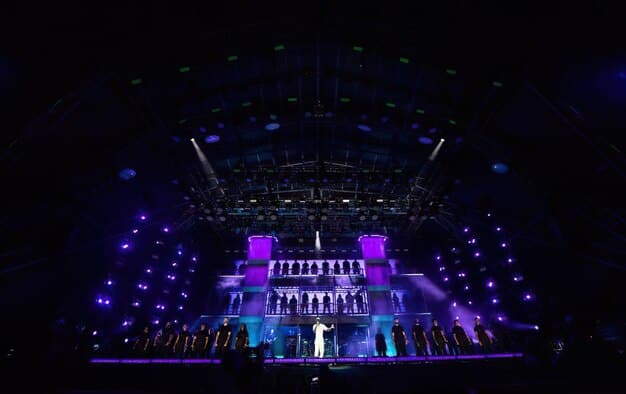K-Pop’s US Rise: Cultural Phenomenon & Economic Impact Explored

K-Pop’s ascendancy in the United States transcends musical trends, evolving into a significant cultural phenomenon with a profound economic impact, reshaping industries from entertainment to fashion and tourism while fostering unprecedented global fan engagement.
The **Rise of K-Pop in America: Exploring the Cultural Phenomenon and Its Economic Impact** represents one of the most compelling narratives in contemporary entertainment. What began as a niche musical genre from South Korea has blossomed into a global powerhouse, profoundly altering the American cultural landscape and creating substantial economic ripple effects across various sectors.
The Genesis of a Global Sensation: K-Pop’s Early Footholds
K-Pop’s journey to America didn’t happen overnight; it was a gradual, meticulously planned, and organically fueled ascent. For decades, South Korean entertainment agencies cultivated a unique blend of music, performance, and fan interaction, learning from Western pop but infusing it with their distinct cultural nuances. This strategic development laid the groundwork for what would eventually become a global phenomenon, captivating audiences far beyond Asia.
The early 2000s saw sporadic attempts by Korean artists to break into the U.S. market, often facing language barriers and a lack of mainstream media exposure. However, the advent of digital platforms like YouTube proved to be a game-changer, allowing K-Pop groups to reach international audiences directly, bypassing traditional gatekeepers. This direct connection fostered early fan communities, laying the essential groundwork for future explosive growth.
Early Influencers and Breaking Barriers
Specific acts played pivotal roles in cracking open the American market. Their initial successes, though modest by today’s standards, demonstrated the potential for K-Pop to resonate with a broader audience.
- Wonder Girls: Pioneered attempts to tour and record in the U.S., even opening for the Jonas Brothers, providing early exposure to American teens.
- Rain: Achieved a high profile through acting roles in Hollywood films and a performance at Madison Square Garden, showcasing individual artist reach.
- BoA: Released an English-language album, signaling a direct intention to enter the U.S. music scene with a major label backing.
These early ventures, while not always leading to immediate chart-topping success, were crucial in introducing the aesthetic, sound, and meticulous production quality of K-Pop to a nascent American audience. They highlighted the genre’s unique appeal, characterized by synchronized choreography, vibrant visuals, and innovative music production that often blended various genres like hip-hop, R&B, and electronic dance music.
The deliberate and sustained efforts to refine the K-Pop idol system, focusing on extensive training in singing, dancing, and foreign languages, also contributed significantly. This rigorous preparation ensured that artists were not only talented performers but also charismatic communicators capable of engaging diverse audiences globally. The cultivation of strong fan relationships through dedicated content and interactive platforms further solidified K-Pop’s presence, turning casual listeners into devout followers.
In essence, the initial phase of K-Pop’s rise in America was characterized by a blend of strategic agency planning, artist dedication, and the opportune timing of digital media’s explosion. These factors collectively built a sturdy foundation, preparing the ground for the massive cultural impact and economic influence that would soon follow.
The Tipping Point: Viral Sensation to Mainstream Adoption
While early efforts laid the groundwork, it was a particular blend of viral success and strategic engagement that propelled K-Pop from a niche interest to a mainstream phenomenon in America. The breakthrough moment often points to a specific digital wildfire, but the sustained momentum that followed was a testament to the genre’s inherent appeal and smart tactical amplification.
The sheer spectacle and novelty of K-Pop served as a powerful magnet. Their music videos, often cinematic and intricately choreographed, commanded attention on platforms like YouTube, generating millions of views and sparking conversations across social media. This visual prowess, combined with catchy melodies and compelling storylines, made K-Pop inherently shareable, driving organic growth and cultivating a passionate, digitally native fanbase.
The “Gangnam Style” Effect and Beyond
Psy’s “Gangnam Style” in 2012 was arguably the pivotal viral moment that smashed through the American consciousness. While qualitatively different from the idol groups that typically define K-Pop, its unprecedented global viral success proved that Korean-language content could captivate a mass American audience. It opened doors and piqued curiosity.
- Global Recognition: “Gangnam Style” shattered YouTube records, becoming the first video to reach one billion views, showing K-Pop’s global potential.
- Media Exposure: Psy’s appearances on major U.S. talk shows and news outlets gave K-Pop a visibility it had never experienced before.
- Curiosity Sparked: The song’s popularity encouraged many to explore other K-Pop artists, expanding the genre’s reach.
Following “Gangnam Style,” the industry demonstrated its ability to capitalize on newfound interest. Groups like BTS and BLACKPINK, already meticulously developed, were perfectly positioned to inherit this expanded stage. Their strategic use of social media, direct fan communication via platforms like Twitter and Weverse, and consistent output of high-quality, relatable content solidified their presence. They moved beyond mere novelty, building genuine, loyal fanbases through authenticity and consistent engagement.
The shift from viral sensation to mainstream adoption also involved a growing acceptance within the American music industry itself. Collaborations with Western artists, appearances on major award shows, and strong sales figures proved K-Pop was not a fleeting trend but a formidable force. The willingness of fans to mobilize for voting campaigns, album purchases, and streaming efforts further demonstrated their significant economic and cultural power, prompting American industry giants to take notice and invest in promoting K-Pop acts.
This period marked K-Pop’s transition from an intriguing foreign import to an undeniable cultural force within the United States. It was the moment when the genre proved its universal appeal and the strength of its dedicated following.
Fan-Centricity: The Engine of K-Pop’s American Success
The unparalleled success of K-Pop in America is undeniably propelled by its unique and intensely engaged fan culture. Unlike traditional Western music industries that often prioritize artist mystique, K-Pop agencies have perfected the art of cultivating a deeply interactive and devoted fanbase. This fan-centric approach is not merely a marketing strategy; it is an integral part of the K-Pop ecosystem, transforming passive listeners into active participants and powerful advocates.
At its core, K-Pop fosters a sense of community and shared purpose among its fans. Official fan clubs, often named and branded, provide a collective identity. This collective identity is strengthened through consistent, personalized content from idols, ranging from behind-the-scenes vlogs and live streams to personal social media updates. This constant connection humanizes the idols, creating a powerful emotional bond that transcends geographical boundaries.
The Power of Fandoms
K-Pop fandoms in America are not just passive consumers; they are highly organized, digitally savvy, and incredibly influential. Their collective actions have demonstrated a significant capacity to drive trends, influence charts, and even impact social causes.
- Mass Streaming and Buying: Fandoms meticulously organize mass streaming parties and album purchase campaigns to push their favorite groups up charts like Billboard.
- Social Media Powerhouses: Fans create trending topics, curate content, and actively promote artists, turning social media platforms into powerful promotional tools.
- Charitable Initiatives: Many fandoms engage in charitable activities in the name of their idols, showcasing a positive community aspect that further attracts new fans.
The high level of fan engagement also extends to the physical realm, with sold-out concerts and elaborate fan events. The iconic “lightstick” culture, where fans wave synchronized, personalized lightsticks, creates a visually stunning and unifying experience at concerts, further cementing the bond between artist and audience. This reciprocal relationship, where artists actively acknowledge and appreciate their fans’ efforts, reinforces loyalty and drives further dedication.

Furthermore, K-Pop agencies often leverage feedback from fan communities to inform their strategies, whether it’s regarding merchandise designs, tour locations, or even content concepts. This sense of inclusion and validation empowers fans, making them feel like active stakeholders in their favorite group’s journey. This organic, grassroots energy, combined with strategic cultivation, has cultivated an American fanbase that is not only large but also fiercely dedicated and economically impactful.
The fan-centric model is a critical differentiator for K-Pop, creating a self-sustaining ecosystem where artists thrive on the devotion of their audience, and fans feel a profound sense of belonging and influence. This symbiotic relationship is arguably the most potent engine driving K-Pop’s continued growth and unshakeable presence in the American cultural landscape.
Economic Footprint: K-Pop’s Multi-Million Dollar Impact on the US
The cultural wave of K-Pop isn’t just about music and dance; it carries a significant <economic current that is reshaping various sectors within the United States. From concert tours generating millions in ticket and merchandise sales to driving tourism and influencing consumer trends, K-Pop has become a formidable economic force that demands attention.
The impact begins directly with the music industry. Album sales, both physical and digital, contribute substantially. However, it’s the touring and live event sector where the economic power truly shines. When a major K-Pop group announces a U.S. tour, tickets often sell out within minutes, sometimes crashing ticketing websites. These concerts not only generate revenue for artists and promoters but also boost local economies through venue rentals, event staff employment, and increased spending on hospitality, transportation, and dining by concert-goers.
Beyond the Stage: Merchandise, Media, and Tourism
The economic tentacles of K-Pop extend far beyond concert halls, reaching into various related industries and creating new revenue streams.
- Merchandise Sales: Official fan merchandise, from lightsticks and apparel to photo cards and albums, generates considerable revenue, often sold through online stores and at concert venues.
- Brand Endorsements: K-Pop idols are highly sought-after brand ambassadors for luxury fashion, beauty products, and technology companies, leveraging their global influence to drive sales.
- Content Creation & Media: Increased demand for K-Pop content fuels growth in local media production, licensing, and streaming platforms, offering new employment opportunities within the entertainment pipeline.
The tourism sector also benefits directly. The allure of K-Pop draws American fans to South Korea, driven by a desire to experience the culture firsthand, visit filming locations, or attend fan events. Airlines, hotels, and tour operators all see increased business from this dedicated segment of travelers. Conversely, when K-Pop artists tour the U.S., it can stimulate internal tourism, with fans traveling across states to attend shows, further boosting regional economies.
Furthermore, K-Pop’s influence on fashion and beauty trends is undeniable. Idols are fashion trendsetters, and their sartorial choices often translate into increased sales for specific brands, both high-end and accessible. This cultural osmosis creates a ripple effect in consumer markets, influencing purchasing decisions and demonstrating the genre’s soft power over economic consumption.
In essence, K-Pop’s economic footprint in the U.S. is multifaceted and ever-expanding. It’s a testament to the power of cultural exchange to not only entertain but also significantly stimulate economic activity, illustrating how a cultural phenomenon can become a robust and dynamic industry within a foreign market.
Cultural Resonances: K-Pop’s Impact on American Society
Beyond its economic might, K-Pop has woven itself into the fabric of American society, eliciting significant cultural resonance that challenges existing norms and introduces new perspectives. This phenomenon is not merely about music consumption; it’s about a broader adoption and appreciation of elements from Korean culture, influencing everything from fashion and language to social discourse and youth identity.
One of the most profound impacts is on diversity and representation within media. K-Pop’s success demonstrates a clear appetite among American audiences for non-English, non-Western content. This challenges the long-standing hegemony of American popular culture and paves the way for greater exposure to and acceptance of diverse artistic expressions. For many minority groups within the U.S., K-Pop offers a sense of representation and empowerment, showcasing Asian talent on a large global stage where it was previously underrepresented.
Breaking Down Barriers and Fostering Connection
K-Pop’s influence extends to fostering new appreciation for language and cross-cultural understanding. Fans often learn basic Korean phrases, explore Korean cuisine, and engage with Korean history and entertainment beyond music.
- Linguistic Curiosity: Many fans are motivated to learn Korean, sparking interest in a new language and culture.
- Cultural Exploration: K-Pop acts as a gateway to broader Korean culture, including K-dramas, food, and historical sites.
- Global Community Building: Fandoms unite diverse individuals from across the U.S. and the world, building bridges through shared passion.
The meticulous aesthetics and high production values of K-Pop music videos and performances have also influenced American artists and producers, raising the bar for visual storytelling and choreography in pop music. The emphasis on synchronized dance and complex stage concepts has become a point of aspiration for many, demonstrating K-Pop’s role as an innovator in the entertainment space.

Moreover, K-Pop idols often serve as positive role models, promoting messages of self-love, mental health awareness, and social responsibility through their lyrics and public activities. This messaging resonates deeply with younger American audiences, providing a sense of comfort and encouragement. The collective action of K-Pop fandoms in support of various social and political causes also illustrates their emerging influence as a cultural force capable of mobilizing for impact beyond entertainment.
In essence, K-Pop’s cultural resonance in America signifies a shift towards a more globalized and interconnected world where cultural boundaries are increasingly blurred. It exemplifies how a musical genre can become a powerful conduit for cross-cultural exchange, challenging conventional views and enriching the diverse tapestry of American society.
Challenges and the Path Forward: Sustaining K-Pop’s American Reign
Despite its undeniable triumph in the American market, K-Pop faces inherent challenges that could shape its future trajectory. Sustaining the current momentum requires continuous innovation, strategic adaptation, and a deep understanding of evolving consumer demands. The relentless pace of the global music industry, coupled with the particular demands of the K-Pop system, presents a complex landscape to navigate.
One significant challenge lies in maintaining artistic freshness and avoiding repetitive formulas. The highly structured idol system, while effective for production, can sometimes lead to a perceived lack of individual artistic freedom or a homogenization of sound. Balancing the successful formula with genuine artistic evolution is crucial to prevent viewer fatigue and ensure long-term engagement from a discerning American audience that values authenticity and innovation.
Navigating Industry Pressures and Cultural Nuances
The path forward for K-Pop in America involves addressing internal industry pressures and skillfully navigating cultural nuances to deepen its roots.
- Artist Burnout: The demanding trainee and idol schedules can lead to burnout, raising concerns about artist well-being and career longevity.
- Language Barrier: While often overcome by dedicated fans, the language barrier can still limit broader mainstream radio play and deeper lyrical appreciation among casual listeners.
- Cross-Cultural Understanding: Misunderstandings or misinterpretations of cultural context can sometimes arise, requiring careful communication and sensitivity from acts and agencies.
Furthermore, the competitive nature of the global music industry means constant pressure from emerging genres and artists. K-Pop agencies must continue to invest heavily in talent development, cutting-edge production, and innovative marketing strategies to stay ahead. Collaborations with Western artists and producers, while beneficial for exposure, must also be executed authentically to avoid diluting the unique K-Pop identity.
The reliance on digital engagement, while a strength, also means vulnerability to shifts in social media platform algorithms and trending content. Diversifying reach beyond these platforms, through traditional media and live experiences, will be vital for sustained growth. Expanding into new formats, such as more extensive documentary content or interactive fan experiences beyond music releases, could also hold the key to deepening loyalty.
Ultimately, K-Pop’s sustained reign in America hinges on its ability to evolve without losing its distinctive charm. This means fostering greater artistic autonomy for idols, investing more in mental health support for artists, and continually adapting marketing and content strategies to resonate with American audiences while preserving the core elements that make K-Pop unique. The journey ahead is complex, but with its strong foundation and dedicated fanbase, K-Pop is well-positioned to continue its impressive trajectory.
Beyond the Hype: The Enduring Legacy of K-Pop in America
As K-Pop solidifies its position in the American entertainment landscape, it’s crucial to look beyond the immediate hype and consider its enduring legacy. The genre is not merely a passing trend but a significant cultural and economic force that has already reshaped perceptions, opened new avenues, and set new benchmarks for global entertainment. Its lasting impact will be felt in various ways, influencing future artistic expressions and industry practices.
One of the most profound legacies will be K-Pop’s role in globalizing popular culture. It has demonstrated unequivocally that music and entertainment transcend linguistic and geographical boundaries. This success has paved the way for other non-Western cultural exports to gain a foothold in markets traditionally dominated by English-language content, fostering a more diverse and interconnected global entertainment ecosystem.
Shaping Future Trends and Industry Models
K-Pop’s influence extends to redefining industry models and shaping future consumer and artistic trends in the American market.
- Fan Engagement Blueprint: The meticulous and proactive fan engagement models pioneered by K-Pop agencies will likely influence how Western artists interact with their audiences.
- Hybrid Performance Standards: The combination of intricate choreography, powerful vocals, and compelling visual storytelling will continue to raise the bar for pop performances globally.
- Diversified Content Consumption: K-Pop has normalized the consumption of foreign-language media, potentially leading to increased demand for non-English content across all entertainment forms.
Moreover, K-Pop has undeniably influenced American artists and producers, inspiring them to incorporate elements of K-Pop’s visual aesthetic, intricate choreography, or genre-bending musicality into their own work. This cross-pollination of creative ideas enriches the global music scene, leading to new and exciting artistic expressions.
The genre’s emphasis on comprehensive artist training – encompassing not just vocal and dance skills but also media training, language acquisition, and a disciplined work ethic – offers a compelling counter-narrative to the often-spontaneous rise of Western artists. This structured approach, while not without its criticisms, has proven immensely effective and may prompt reevaluation of talent development strategies within the American industry.
Ultimately, K-Pop’s enduring legacy in America will be its indelible mark on how global music is created, marketed, consumed, and appreciated. It is a testament to the power of cultural exchange, demonstrating that artistic excellence, coupled with strategic fan engagement, can transform niche interests into mainstream phenomena, leaving a lasting imprint on both culture and economy for generations to come. The “fever” may ebb and flow, but the fundamental shifts K-Pop has instigated in the American entertainment landscape are here to stay.
| Key Aspect | Brief Description |
|---|---|
| 🎵 Cultural Phenomenon | K-Pop infused American culture with diverse music, fashion, and visual artistry, challenging Western dominance. |
| 💸 Economic Impact | Significant revenue from tours, merchandise, brand deals and boosts to tourism and local economies. |
| 🤝 Fan-Centric Approach | Deeply engaged fan communities drive success through active support, streaming, and purchasing power. |
| 📈 Future Growth | Continued innovation and strategic adaptation are key for K-Pop to maintain its influential presence. |
Frequently Asked Questions About K-Pop in America
The rise of K-Pop in the US is primarily attributed to a combination of factors: the advent of social media platforms like YouTube for global reach, highly polished and visually appealing music videos, synchronized choreography, and a strong emphasis on fan engagement and community-building, which turned casual listeners into dedicated fans.
K-Pop significantly impacts the US economy through massive revenue generation from concert tours, merchandise sales, and brand endorsements by K-Pop idols. It also boosts local economies by increasing tourism, driving hospitality and transport spending, and spurring investment in related industries like content creation and media production.
While some initially doubted its longevity, K-Pop has demonstrated itself to be a lasting phenomenon rather than a temporary trend in America. Its sustained chart success, dedicated multi-generational fanbase, and deep cultural integration suggest it has cemented its place in the mainstream entertainment landscape for the foreseeable future, continuously evolving and adapting.
Beyond music, K-Pop has profoundly influenced American culture by promoting greater cultural diversity and acceptance of non-Western content. It has inspired fashion and beauty trends, encouraged linguistic curiosity in Korean, and fostered global community building among diverse fanbases. Idols also often promote positive social messages, impacting youth identity.
K-Pop faces challenges in maintaining its US popularity, including the intense pressure for continuous innovation to avoid formulaic repetition within its structured system, potential artist burnout from demanding schedules, and the ongoing need to bridge cultural and language barriers effectively. Adapting to evolving digital trends and strengthening local industry partnerships are also crucial for sustained growth.
Conclusion
The Rise of K-Pop in America: Exploring the Cultural Phenomenon and Its Economic Impact is a testament to the power of cultural exchange in a globalized world. What began as a strategic export has blossomed into a deeply ingrained element of the American entertainment industry and cultural consciousness. Its journey highlights not only the universal appeal of high-quality music and performance but also the transformative power of dedicated fandoms and innovative digital strategies. As K-Pop continues to evolve, its enduring legacy will be defined by its ongoing ability to connect, inspire, and shape the future of entertainment on both sides of the Pacific.





